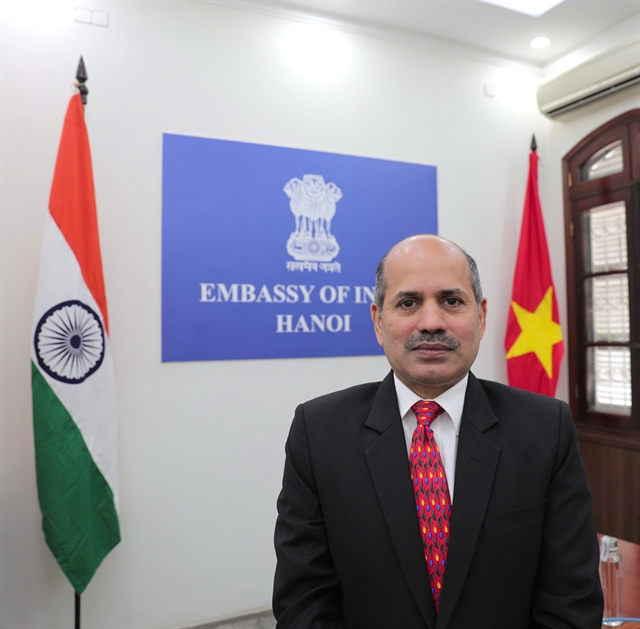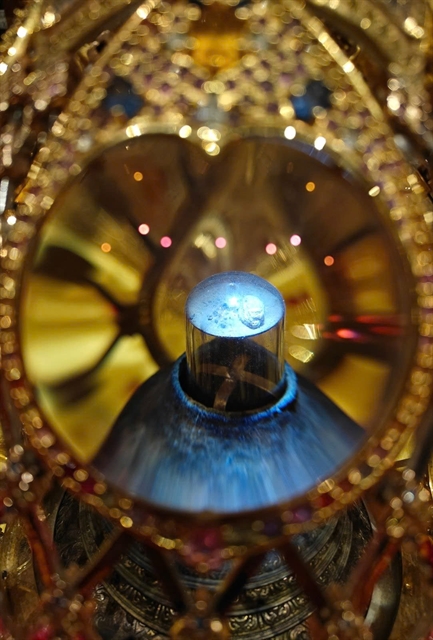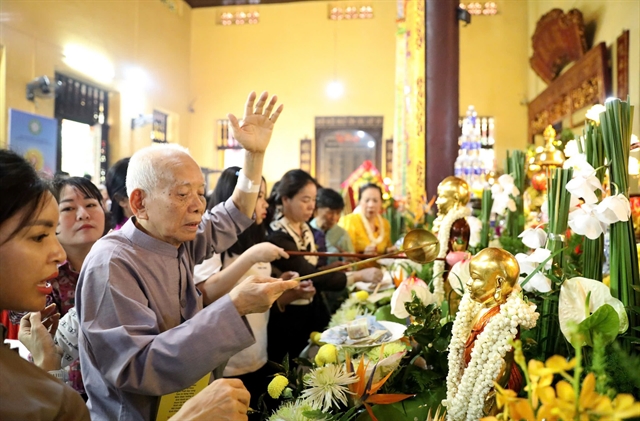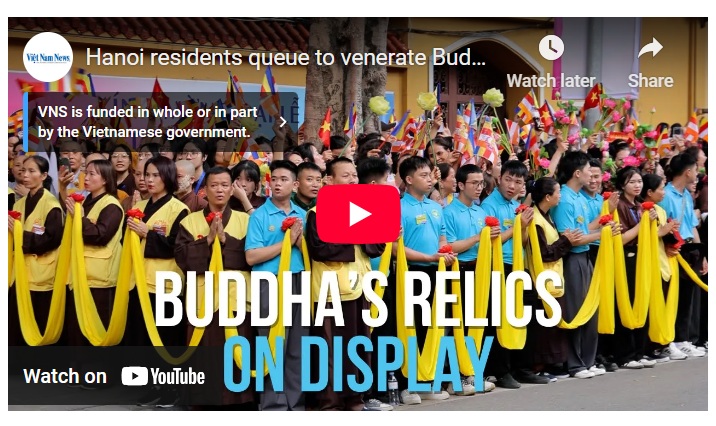- Home
- Embassy
- Consular Services
- Bilateral Relations
- Economic & Commerce
- Development Partnership
- Media
- Links
- Tourism & Culture
- Contact
Buddhism is the core of relations between India and Vietnam: ambassador
Việt Nam News reporter Lê Hương * interviewed the Indian Ambassador to Việt Nam, Sandeep Arya, on bringing sacred relics of Buddha to various locations in Việt Nam during the celebration of Vesak Day 2025.
Việt Nam News reporter Lê Hương * interviewed the Indian Ambassador to Việt Nam, Sandeep Arya, on bringing sacred relics of Buddha to various locations in Việt Nam during the celebration of Vesak Day 2025.

Indian Ambassador to Việt Nam Sandeep Arya. VNS Photo Bảo Hoa
Could you brief us on the origin of the sacred relics of Buddha that you brought to Việt Nam this time?
These are sacred relics of Lord Buddha, and these relics have been discovered in India, in the state of Andhra Pradesh.
These were authenticated at that time by the Archaeological Survey of India. At that time, the request was made, during the British period, close to 95 years ago, by the Governor General of India, Lord Willingdon, who handed over the relics to the Mahabodhi Society, on the condition that these would be stored at a place called Sarnath. So, for the last 95 years, the relics have been kept at Sarnath, near Varanasi, which is associated with Lord Buddha, where he gave his first sermon.
So, I think these are well-authenticated, very widely regarded relics of Lord Buddha. These have been safely kept and have been specially brought to Việt Nam for this period from May 2 - 21. If I can just also show you this declaration, this is a formal declaration by Lord Willingdon saying, at the time of handing over, the genuineness, the authenticated nature of the relics, and these are, of course, among the most respected relics of Lord Buddha, which are enshrined in India.
Did you have any challenges during the process of bringing them here to Việt Nam?
The holy Buddha relics, I think, are associated with the highest protocol in India.
So, the approval process itself requires a kind of formal approval, which goes to the highest level in the Government of India. So, after the request was received from the Vietnamese side, from the Government and Vietnamese Buddhist Sangha, it went through a process of consideration in India, because these relics are dealt with very high protocol and due respect in the sacrosanct nature of the relics.
At some stage, we also had lots of clarification, lots of, you know, questions about the process itself, about where they would be kept. About three weeks ago, we had a visit from an advanced team from India, which inspected all the sites, the four sites at which the relics will be placed. It also discussed procedures in great detail, such as how they will be kept and how things will be done.
So, I think the process has been ongoing for the last few months. We are happy that this could be realised, and it happened to coincide with the UN Day of Vesak. There is a group of the Mahabodhi Society in India, which is the custodian of these relics.
Their monks have been accompanying the relics, and they are also participating in the entire process. It is a joint activity in terms of the arrival at Hồ Chí Minh City Airport, with a ceremonial reception, prayers and the political leadership. As you know, the Indian minister accompanied them, and the minister will also accompany them back.
So, I think we have been working a lot on various aspects relating to the visit, and it has all worked out smoothly over a period of time.

The sacred relics of the Buddha from India. Photo courtesy of the Embassy
How do you think such an event helps enhance the people-to-people diplomacy between the two countries?
I think there are two dimensions to it.
One is, I think, between India and Việt Nam, there is a huge amount of respect. The life and message of Lord Buddha are widely regarded by the people, and they have had an influence on India, and also globally, which is represented by the International Day of Vesak. So, one is upholding the message and the teachings of Lord Buddha, their relevance for the contemporary world.
It was very interesting that the title of the Vesak Day, which was observed last week in Hồ Chí Minh City, with international participation, the theme was about the Buddhist insights into the contemporary issues faced by the world in terms of peace and sustainable development.
So, I think one is upholding the message of Lord Buddha and its relevance for the present world. Second is obviously its bilateral nature. I feel that in the relations between India and Việt Nam, Buddhism is at the core of some of the oldest historical links, because it is very widely believed in India and Việt Nam that it was where the first Buddhist monks arrived, close to 2,000 years ago from India to Việt Nam carrying the message, and they have had very wide appeal.
And I think there is a lot of respect because of that between the people of India and the people of Việt Nam. Subsequently, there have been various links, including traders, which also carried the message of Lord Buddha.
If you have time, I can try to explain. We have also had an exhibition of similarities, which is not purely spiritual because spiritual connection and the people's belief system are just one aspect of Lord Buddha and Buddhist heritage. But the other aspects are, as shown by researchers, a comparison of art and culture.
And this exhibition, which was displayed in Hồ Chí Minh City, brought out that the design of monasteries, the sculpture and various forms of Buddha statues, etc., there are lots of, you know, similarities carried over for a long period of time. Some of them date back to the 7th and 8th centuries. There is a very famous monastery called Đồng Dương Monastery near Đà Nẵng City.

People wash the statues of Buddha in a celebration of Buddha's birthday, which falls on the 15th of the fourth lunar month. VNA/VNS Photo
So, they have looked at the design of the monastery, the sculptures and statues, etc. and how similar it was to the monastery kind of structures and the architecture and the design in India, which meant that apart from spiritual thought, I think the exchange of art and culture through a very long period of 1,500 to 2,000 years period has been an active exchange between the two countries. We also had this group from India, which performed at the Hà Nội Opera House on May 12. I think they represented in the form of art, dance, and drama the journey of Gautama Buddha.
So, I think it is reflected in spiritual thinking, it is reflected in art and culture, and it is represented in the present, in terms of presentation and appreciation.
So, I believe that the visit of the holy Buddha relics to Việt Nam, I think, deepens those bonds, deepens that association with Lord Buddha and his message and also with art, culture and various other forms of the way people connect with each other, the kind of affinity and bonds people in India and Việt Nam feel towards each other. I think in India also there is lot of appreciation, lot of warmth for the way the Lord Buddha relics have been received in Việt Nam, the kind of strong appeal and strong kind of respect that they have received in the city of Hồ Chí Minh City and in Tây Ninh province over the last ten days or so.
We look forward to the next nine days of the visit of relics, which will then be in Quán Sứ Pagoda in Hà Nội, followed by the visit to Tam Chúc Pagoda, which was also the venue of the last UN Day of Vesak, which was observed by Việt Nam. VNS
(*with an additional interview by Bảo Hoa)
